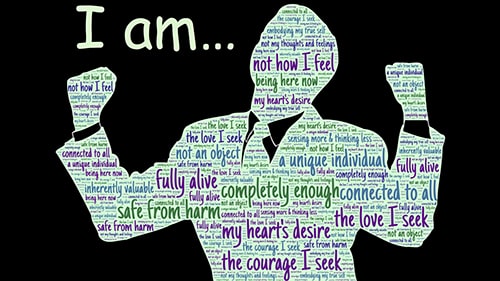sustaining attention

in this program
- three attention skills
- balancing states
- what happens during the state of awareness?
- expanding the field of awareness
- presence
- mindfulness in everyday action, interaction
as we saw earlier on this topic, mindfulness is a form of attention which strengthens through practice. like the act of walking, mindfulness is a collection of skills, all of which grow in capacity with practice. we do not need to learn from scratch, because we already have the basic capacity, namely attention. we already know how to pay attention, but we may not be aware that this state of attention can be developed and brought into the areas of our interaction where it is most necessary.
three attention skills

looking into the three different skills comprising mindfulness, we notice that, although each is unique, it is their working together which allows mindfulness to arise in consciousness.
- continued focused attending
this consists of selecting an object or focal point for attention, and keeping attention fixed on it. we stay with what is relevant, noticing our reactions and bringing attention back to our chosen focal point. as our capacity grows, we expand attention to include more objects. rather than having only one focal point, we begin to develop a field of attention. - sensory claritywhereas our focus can be likened to the penetrating beam of a searchlight, sensory clarity would be the light itself. we bring greater clarity to the field of attention. as i allow the mind to be stilled in its object of focus, staying with the relevant information, i might begin to see more, noticing things i did not notice before. and there is a sense of curiosity, as if the light takes pleasure in knowing itself more clearly.
- an allowing openness (peacefulness)
when we meet reality without resistance (pushing away, attacking, reacting, withdrawing), and simultaneously allow all the senses to be expanded, there is a sense of acceptance, or equanimity. mind is not overwhelmed by what it perceives, and maintains a balance between being pulled away by senses or thought (grasping) and repressing information (resistance).

mindfulness is awareness that arises through paying attention, on purpose, in the present moment, nonjudgmentally.

Jon Kabat-Zinn

balancing states of consciousness

the state of mindfulness is not a “something” which you can reach through doing, or thinking about, but an active process of regulating other less functional states, to experience the ever-present mindfulness. it is naturally present when you’re not caught in another state, like anger or non-attention.
reflect on what your mental state is like when you’re concentrating. you may be deeply focused on something, to such an extent that you cannot respond attentively to someone who might be talking. absorption is a state where consciousness draws even more inward, so that you also lose connection with external senses. you are not asleep, but deeply absorbed in your interior experience. on the other side of states of consciousness, we are all familiar with identified thought. you think unconsciously (you are lost in thought), and your mental state naturally changes to whatever you’re identified with in that moment. one moment you feel good because something has come together. the next, you’re upset because something has fallen apart. such identified thought turns into reaction, where you’ve become so deeply identified with your interpretation of what is happening in your (unconscious) thinking world, that you “see” a clear “right,” or “wrong.” you feel either a deep longing (wanting), or intense irritation/fear (not wanting). your reaction speaks of what you find unbearable, or “must (not) have.” your reaction has little to do with the situation itself.
with mindfulness, we become aware of these processes that happen in our states of consciousness, and continually restore or sustain the mindful state. we are aware of our experience (attentive), openly accept what appears in consciousness (good or bad), and discern the different sensate and interior voices in our experience with clarity (inner-outer awareness). we maintain this balance through applying more awareness to the sense field when we feel ourselves drawing into concentration or absorption, and applying greater focus (on the mindfulness object) when mind becomes identified, follows thought, or becomes reactive.
mindfulness is always "on"
let’s see whether we can recognize the state of mindfulness in our memory. do you remember a time when you experienced a state of deep, curious focus? we may even remember becoming so deeply focused that everything slowed down, and we experienced a “flow” state in which things felt effortless and self-fulfilling. such a state is an example of the focused aspect of mindfulness. due to the right conditions, it appeared temporarily, but we can develop our mindfulness to the point where we can choose to enter into it easily.
in that state the senses experience with great clarity and vividness. you may have recognized this enhanced clarity at the time, and even your memory of the state will be vivid and rich. the state is reflective of the sensory clarity of our experience. when mindfulness matures, this state is easily recognizable in our experience, and can be accessed at will.
some of those vividly alive moments in your life may have been associated with pain or an accident. and yet, whilst you were in the experience, there was no sense of time or discomfort, even though you may have been in a situation of being wounded. that is an example of an allowing openness, or peacefulness. at the time it happened, it was the product of shock, but when mindfulness matures, it becomes part of everyday experience.

the way to experience nowness is to realize that this very moment, this very point in your life, is always the occasion. so the consideration of where you are and what you are, on the spot, is very important. that is one reason that your family situation, your domestic everyday life, is so important. you should regard your home as sacred, as a golden opportunity to experience nowness. appreciating sacredness begins very simply by taking an interest in all the details of your life. interest is simply applying awareness to what goes on in your everyday life – awareness while you’re cooking, awareness while you’re driving, awareness while you’re changing diapers, even awareness while you’re arguing. such awareness can help to free you from speed, chaos, neurosis, and resentment of all kinds. it can free you from the obstacles to nowness, so that you can cheer up on the spot, all the time.

Chögyam Trungpa
what you miss in identified thought

grey lines indicate field of thought. gold lines represent field of awareness. – thank you R. Genn for the image.
most of us will be more familiar with the opposite states to mindfulness. we may remember situations where, due to being unfocused or inattentive, we missed important information, and found ourselves in a pickle. inattentiveness is the cause of accidents, relationship misunderstandings, poor communication, and harm. it is also a deep disrespect to your own presence, and that of the other. lack of sensory clarity will include states of overwhelm, where you felt so flustered that you became self-conscious, or self-absorbed, and reactive. lack of clarity leads to confusion and suffering. the opposite state to peaceful, is fear. you may even be in a good experience, or enjoying something, and start feeling fear for losing it, or not getting enough of it. this restless thinking state is so focused on outcomes, that it cannot be present to enjoy the experience.
what happens during the state of awareness?
regulation of attention — the ability to focus and hold attention, receiving more
information.
sense awareness — awareness of field, grounded in “now” rather than
thought/feeling.
dual awareness — awareness of awareness, that includes experiencing (witnessing)
self, mental processes, the other, and the relational space.
emotion regulation — supports consciousness to recognize triggers and inhibit
reaction.
healthy adaptation and agency — the world is not happening to me (victim), but from me (agency).
one way in which we can understand the nature of awareness is to see mind-body as a screen or canvas where interactions between brain and senses continually create a changing image or movie. visualize something, and the image changes. focus on the next few breaths, and it changes again. the object of our practice is to notice what fills the canvas in each moment. we become aware of the content of our awareness. attention is like the beam of a spotlight. it picks out an object amongst many, and focuses on it. it then maintains that priority (object) in awareness. the effect is a mind that feels anchored and in the “now.” awareness is the light itself. it is aware of its own beam (attention), as much as its field (senses and interior perception). the final ingredient is allowing, accepting, or being with our experience.
expanding the field of awareness

the moment you start watching your thoughts, a higher level of consciousness becomes activated.

Eckhart Tolle

as we pointed out in bare attention, the object of our attention keeps expanding. we typically start with focusing our attention on the breath and, once we can hold this focus stable, we include sensate awareness (the five senses).
when this ability becomes stable, we may include bodily interior sensing and our feeling orientation (“want,” “don’t want,” and “don’t care”). you may notice that we’re now working with our judgment and allowing ourselves to experience without choice.
when we’ve become settled in that ability, we can include mindfulness of thought. now we are deeply aware of the mental processes, and to the extent that we can understand the processes, we can work with them.
finally, we include the full range of experience and of consciousness.
that is the theoretical understanding. in our practice, we may find ourselves all over the place. if this happens, it tells us that attention is not yet stable, and that we need to reduce the scope of focus of our attention. in practice, this may simply mean stabilizing focus by returning attention to the experience of breathing.

presence
when we are present to ourselves and another, we are alert without being vigilant. we’re alert, not out of fear, but out of love. this means we are truly interested and ready to respond. in meeting with another or a situation, we orient ourselves by focusing on specific information, not with the intent to defend, but to understand. we’re also aware of our own interior state, as much as that of the other, and continually applying emotion regulation to stay present to this moment.
- alertness (ready in response)
- orienting (selective of stimuli)
- emotion regulation
- conflict monitoring (executive function chooses response).

mood and emotion can change from moment to moment. take a moment right now and feel into your own mood. can you identify it? now think of one of your simple pleasures. has the emotion changed? emotion regulation (self-regulation) means that we are employing strategies to influence which emotions arise, when and how long they occur, how they’re experienced, and how they’re expressed. mindful people would easily report that they experience less negative emotions, since they manage them as soon as they arise.

the most precious gift we can offer others is our presence. when mindfulness embraces those we love, they will bloom like flowers.

Thich Nhat Hahn


when the mind is full of memories and preoccupied by the future, it misses the freshness of the present moment. in this way, we fail to recognize the luminous simplicity of mind that is always present behind the veils of thought.

Matthieu Ricard

mindfulness as part of everyday action
so, what does it mean then to be present for reality? it means to perceive directly (through the senses and perception), without interpretation, defense, or identification. to be like a mirror (to reality) where nothing is distorted, and nothing remains when the reflection changes. this is not easy. our cognitive distortions, emotional interpretation and defensiveness are ingrained in our behavior and speech. we therefore need to become mindful so that we can notice our blind spots if we are to see more clearly. and it is totally possible. we can begin the journey by keeping the following in mind in our daily being.
- learn to apply focus and shift attention back to a chosen object of focus (the knowing-feeling of the breath; clarity of awareness, of another, a situation).
- recognize thought identification (as in planning, or wanting a particular outcome, or having to have things only your way).
- recognize strong emotion and identified emotion ("right"/"wrong").
- learn to bring attention back to direct sensate awareness (feeling-knowing through listening, seeing, sensing (tactile) and awareness of space around yourself).
- ground yourself in the focal point (attention) and expand sensory awareness (awareness).
mindfulness in daily interaction

be there as the witness of your mind.

Eckhart Tolle

see resources below for more information on practicing mindfulness in everyday life.


